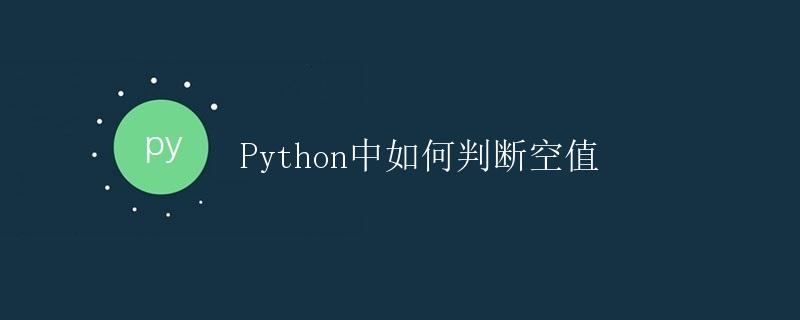Python中如何判断空值

1. 介绍
在Python编程中,经常需要判断某个变量或值是否为空。空值是指在程序执行过程中没有被赋值的情况,或者是被赋值为特定的空值对象。判断空值对于程序的正确执行和逻辑判断非常重要。
本文将详细介绍Python中如何判断空值的方法,包括判断None、空字符串、空列表、空字典、空元组和空集合等情况。
2. 判断None
None 是Python中表示空值的关键字,表示没有值。在Python中判断一个变量是否为None,可以使用关键字is:
x = None
if x is None:
print("x is None")
else:
print("x is not None")
运行结果:
x is None
如果变量x为None,则输出”x is None”;否则输出”x is not None”。
3. 判断空字符串
空字符串是指长度为0的字符串。在Python中判断一个变量是否为空字符串,可以使用以下方法:
3.1 使用len()函数
可以通过使用len()函数获取一个字符串的长度,判断是否为0:
x = ""
if len(x) == 0:
print("x is an empty string")
else:
print("x is not an empty string")
运行结果:
x is an empty string
如果变量x是空字符串,则输出”x is an empty string”;否则输出”x is not an empty string”。
3.2 使用直接判断
由于空字符串在逻辑判断中被认为是False,我们可以直接判断一个字符串是否为空字符串:
x = ""
if not x:
print("x is an empty string")
else:
print("x is not an empty string")
运行结果与上述相同。
4. 判断空列表
空列表是指长度为0的列表。在Python中判断一个变量是否为空列表,可以使用以下方法:
4.1 使用len()函数
可以通过使用len()函数获取一个列表的长度,判断是否为0:
x = []
if len(x) == 0:
print("x is an empty list")
else:
print("x is not an empty list")
运行结果:
x is an empty list
如果变量x是空列表,则输出”x is an empty list”;否则输出”x is not an empty list”。
4.2 使用直接判断
由于空列表在逻辑判断中被认为是False,我们可以直接判断一个列表是否为空列表:
x = []
if not x:
print("x is an empty list")
else:
print("x is not an empty list")
运行结果与上述相同。
5. 判断空字典
空字典是指没有任何键值对的字典。在Python中判断一个变量是否为空字典,可以使用以下方法:
5.1 使用len()函数
可以通过使用len()函数获取一个字典的长度,判断是否为0:
x = {}
if len(x) == 0:
print("x is an empty dictionary")
else:
print("x is not an empty dictionary")
运行结果:
x is an empty dictionary
如果变量x是空字典,则输出”x is an empty dictionary”;否则输出”x is not an empty dictionary”。
5.2 使用直接判断
由于空字典在逻辑判断中被认为是False,我们可以直接判断一个字典是否为空字典:
x = {}
if not x:
print("x is an empty dictionary")
else:
print("x is not an empty dictionary")
运行结果与上述相同。
6. 判断空元组
空元组是指没有任何元素的元组。在Python中判断一个变量是否为空元组,可以使用以下方法:
6.1 使用len()函数
可以通过使用len()函数获取一个元组的长度,判断是否为0:
x = ()
if len(x) == 0:
print("x is an empty tuple")
else:
print("x is not an empty tuple")
运行结果:
x is an empty tuple
如果变量x是空元组,则输出”x is an empty tuple”;否则输出”x is not an empty tuple”。
6.2 使用直接判断
由于空元组在逻辑判断中被认为是False,我们可以直接判断一个元组是否为空元组:
x = ()
if not x:
print("x is an empty tuple")
else:
print("x is not an empty tuple")
运行结果与上述相同。
7. 判断空集合
空集合是指没有任何元素的集合。在Python中判断一个变量是否为空集合,可以使用以下方法:
7.1 使用len()函数
可以通过使用len()函数获取一个集合的长度,判断是否为0:
x = set()
if len(x) == 0:
print("x is an empty set")
else:
print("x is not an empty set")
运行结果:
x is an empty set
如果变量x是空集合,则输出”x is an empty set”;否则输出”x is not an empty set”。
7.2 使用直接判断
由于空集合在逻辑判断中被认为是False,我们可以直接判断一个集合是否为空集合:
x = set()
if not x:
print("x is an empty set")
else:
print("x is not an empty set")
运行结果与上述相同。
8. 总结
本文介绍了如何在Python中判断空值的方法,包括判断None、空字符串、空列表、空字典、空元组和空集合。了解如何判断空值对于编写健壮的程序非常重要,可以避免因空值引发的错误。根据数据类型的不同,我们可以使用is和比较运算符==,或者直接使用空值在逻辑判断中的特性来进行判断。以上方法可以帮助你在实际编程中判断空值的情况。
 极客教程
极客教程